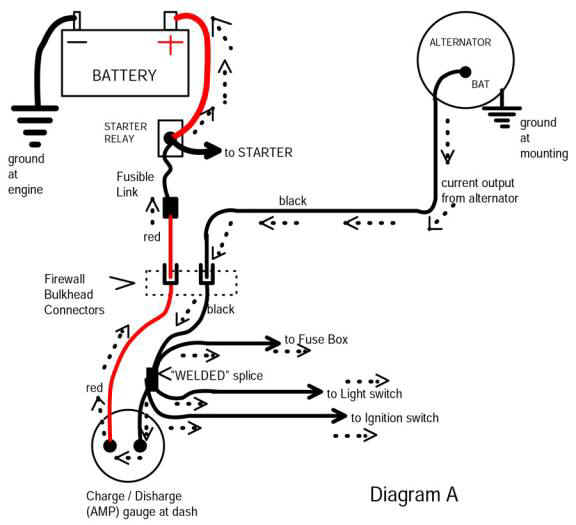NOW FOR the correct answer.
It is important to understand how the Mopar starting/ run circuits work, and that the "ignition switch" is actually SEVERAL completely separate switches in the "can" that we call the "ignition switch."
1---ACCESSORY, hot in both "run" and "acc" feeds the switched buss in the fuse panel
2--IGN RUN, or IGN1, traditionally blue, hot ONLY in run NOT active when cranking.
3--START, traditionally yellow, hot only in "start", goes ONLY from switch, through BULKHEAD and to the start relay. On cars with seat belt interlock, is in series with the reset relay for the seat belts
4--BYPASS, or IGN2, traditionally BROWN hot ONLY in start and IS SEPARATE from "start" above. It only goes one place --from switch, through the BULKHEAD and to the coil+ side of the ballast resistor.
IT IS important to note that NONE of these circuits are fused. Even though the main feed has a "fuse link" I am personally aware of cars which have burned up an entire ignition harness before the lame-assed fuse link blew!!!
TO CHECK VOLTAGE DROP.
You have TWO circuits to check, "run" and "bypass" in start
To check RUN
Turn key to "run" with engine OFF. Hook one probe of your meter to the ignition buss under the hood. ON 69/ earlier cars, the IGN terminal of the regulator is OK, on 70/ later the blue alternator field wire is OK. IN YOUR CASE you should have a single point where the old ignition, the brown bypass, and the MSD "small red" are all spliced together. This is where you want to check
Hook the other probe to battery PLUS. You are hoping, here, for a very LOW reading, the lower the better. If you read over .3V (three tenths of one volt) you have a voltage drop problem.
Now check the same thing in "start."
On NON CD ignitions, hook one probe to the coil + IN YOUR CASE with MSD leave the probe at the brown/ red msd splice, and hook the other probe to battery plus. Disable the ignition by hooking the coil high tension wire to ground. Crank the engine, and while it is cranking, check the voltage. YOU MUST CRANK THE ENGINE by using the KEY and NOT by jumpering the start relay.
Read the voltage and again, you are hoping for a low voltage, the lower the better.
If you read "too much" voltage drop in either case above, you are checking the circuit "path:"
From battery -- fuse link -- bulkhead connector (main red battery feed) -- to ammeter -- through ammeter -- to ammeter black wire -- to factory welded splice -- to ignition switch connector -- through the switch -- back out the connector -- back through the bulkhead (run is blue, start is brown) -- and to the MSD "small red"
So your top suspects are:
bad connections in the bulkhead connector. Read this MAD article for the hows and whys. Even if you do not do this bypass, this article gives a good overview of the problems and a good simplified diagram
http://www.madelectrical.com/electricaltech/amp-gauges.shtml
If you a factory wiring harness, there are at least FIVE possible bad connections that can prevent starting/ running
RED battery feed from the fuse link to the ammeter
BLACK actually only affects charging
BLUE ignition run
BROWN ignition bypass
YELLOW "start." would cause a "non crank" or intermittent
AMMETER connections, either bad wire ends, loose nuts, or problems internal to the ammeter
FACTORY welded splice. In my lifetime, I'm aware of at least 6 of these that have failed. This is a factory splice a few inches from the ammeter terminal in the black wire, which branches off and feeds headlights, accessory "hot" bus, and the IGNITION SWITCH power feed, and one or two other things.
SWITCH CONNECTOR. If the IGN switch connector gets hot/ damaged/ burned, you won't get full voltage to/ through the switch, or depending, OUT of the switch
SWITCH. The switch contacts themselves can become damaged. Since there are several separate contacts, this means it can manifest in several ways.
http://www.madelectrical.com/electricaltech/amp-gauges.shtml

















